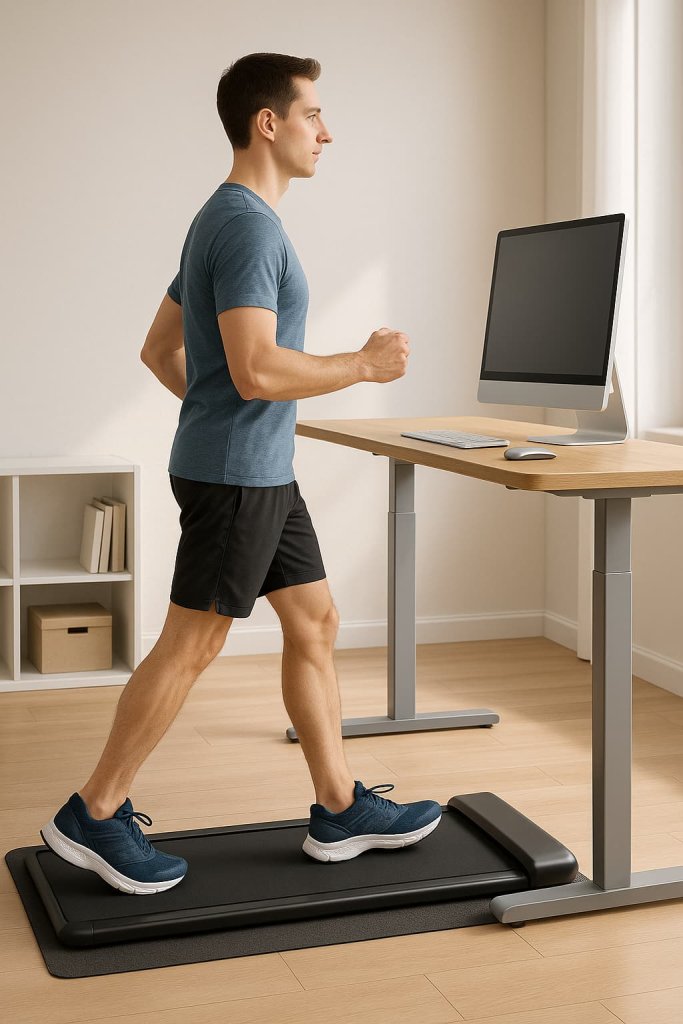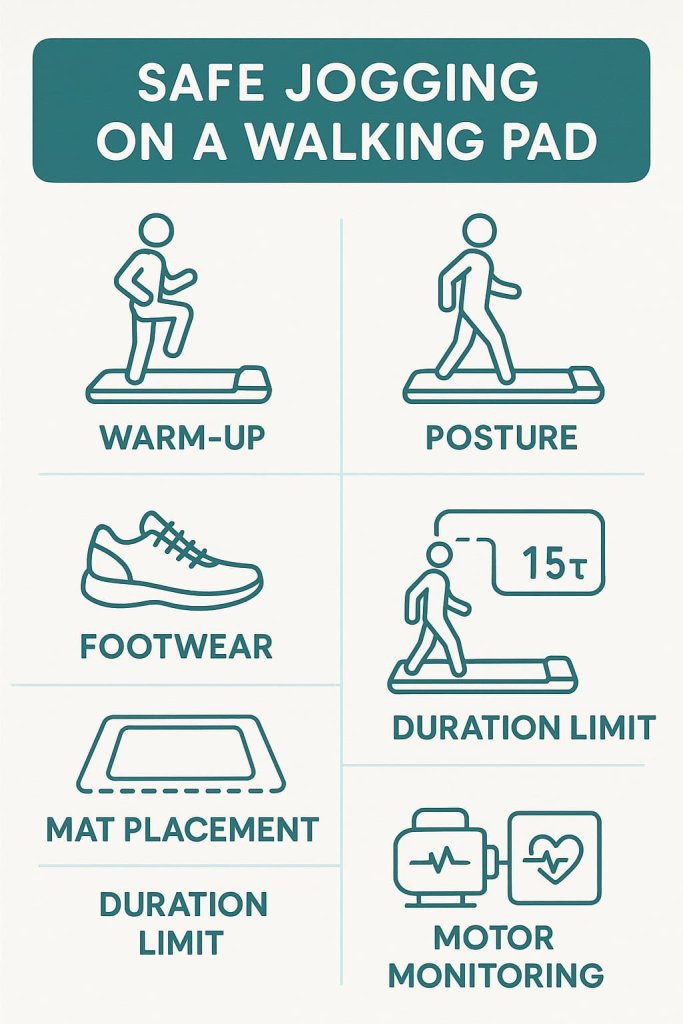Yes, you can jog lightly on some walking pads — but most are not designed for running. Walking pads (also called under-desk treadmills) are built primarily for walking or slow, steady movement. Understanding their speed limits, deck size, and safety features is essential before attempting any form of jogging or running.

This guide explains exactly when it’s safe to run on a walking pad, the key differences from standard treadmills, and expert-backed safety tips to protect both your body and your machine.
What Is a Walking Pad?
A walking pad is a compact, motorized treadmill designed for low-impact walking workouts. Unlike traditional treadmills, walking pads are foldable, lightweight, and often used under standing desks for home or office exercise.
- Average deck length: 40–48 inches
- Average width: 15–18 inches
- Typical top speed: 3–4 mph (4.8–6.4 km/h)
- Motor power: Around 1–1.5 HP, compared to 2.5–4 HP for treadmills
According to Garage Gym Reviews (2025) and Verywell Fit (2024), most walking pads are engineered for continuous low-speed use, not high-impact running.
Can You Run or Jog on a Walking Pad?
You can jog on select models—but not all walking pads are suitable for running.
Light jogging is possible if:
- The walking pad supports speeds of 6–7.5 mph (9.6–12 km/h)
- The deck is long enough for your stride (at least 48 inches)
- The motor is rated above 1.75 HP continuous duty
- The device includes foldable handrails or stability grips
Brands like KingSmith WalkingPad R2 Pro and WalkingPad X21 feature “dual modes” (walking + jogging) with speeds up to 12 km/h, allowing short jog sessions. However, experts emphasize using these speeds sparingly to avoid belt or motor stress.
TechRadar’s 2025 review notes: “No walking pad convincingly replaces a treadmill for running — deck size, stability, and cushioning simply aren’t comparable.”
Why Running on a Walking Pad Can Be Risky
| Concern | Details | Source |
|---|---|---|
| Motor strain | Most motors are not designed for prolonged high-speed use; running may overheat them. | Garage Gym Reviews, 2025 |
| Deck length limits | Short decks restrict stride, forcing awkward steps or balance loss. | Verywell Fit, 2024 |
| No handrails | Most models lack safety rails, increasing fall risk during running. | Orlin Cohen, 2025 |
| Shock absorption | Thinner belts and lighter frames transmit more impact to knees and joints. | Time Health, 2024 |
| Warranty void | Running on non-rated models may void warranty or damage belts/motors. | Manufacturer FAQs, 2024 |
Bottom line: Walking pads are optimized for walking efficiency and space-saving—not high-speed durability.
Safe Jogging Tips on a Walking Pad

If your walking pad includes a “running” or “jogging mode,” following expert-backed safety guidelines is essential to prevent injuries and extend your machine’s lifespan. While these devices are designed for low-impact movement, safe operation practices can make short jogging sessions both effective and secure.
- Start Slow: Warm up at 2–3 mph (3.2–4.8 km/h) before increasing speed to allow your muscles and balance to adjust.
- Wear Proper Footwear: Use well-cushioned, non-slip running shoes that support proper gait and absorb impact.
- Maintain Posture: Keep your monitor at eye level to avoid leaning forward; engage your core and keep shoulders relaxed.
- Check Stability: Position the walking pad on a flat, hard surface—avoid thick carpets—and use a treadmill mat for added stability and motor ventilation.
- Limit Duration: Restrict jogging sessions to 15–20 minutes to reduce overheating and mechanical wear.
- Cool Down: End each session by lowering your speed to 2 mph (3.2 km/h) for at least three minutes to safely lower your heart rate and prevent belt strain.
- Monitor the Motor: Stop immediately if you detect excessive heat, burning smells, or unusual noises, as these can signal motor stress or belt misalignment.
For official U.S. safety information on home exercise equipment, including treadmills and walking pads, visit the U.S. Consumer Product Safety Commission’s Exercise Equipment Safety Center at CPSC.gov – Exercise Equipment Safety.
Following these guidelines helps ensure your walking pad workouts remain safe, effective, and long-lasting, whether you’re walking, briskly striding, or performing short jogging intervals.
Walking Pad vs. Treadmill: Which Is Better for Running?
| Feature | Walking Pad | Treadmill |
|---|---|---|
| Motor Power | 1–1.5 HP | 2.5–4 HP |
| Top Speed | 3–7.5 mph | 10–12 mph |
| Deck Length | 40–48 inches | 55–60 inches |
| Handrails | Usually absent | Always included |
| Shock Absorption | Minimal | Advanced cushioning |
| Best For | Walking, light jogging | Running, sprinting, HIIT |
Verdict: If your primary goal is cardio training or speed workouts, invest in a treadmill. Walking pads are ideal for daily step goals, office fitness, and steady walking routines.
Expert Recommendations
- Light Jogging Only: Reserve running speeds for hybrid pads rated above 7 mph.
- Short Intervals: Use jogging for warm-ups or bursts, not continuous runs.
- Surface Care: Avoid carpet placement to ensure airflow and prevent motor strain.
- Consult a Trainer: If you plan to train regularly at higher intensities, a treadmill is the safer, long-term option.
FAQ
1. Can you run on a walking pad every day?
No. Frequent running on non-rated pads can wear out the motor and shorten lifespan.
2. What’s the maximum speed for running on a walking pad?
Typically 6–7.5 mph for hybrid models; standard walking pads top out at 3.7 mph.
3. Can running on a walking pad cause injury?
Yes, if the deck is too short or unstable, it may increase joint and balance stress.
4. How long can you jog safely on a walking pad?
Short intervals of 10–20 minutes, depending on model and heat buildup.
5. Does running void the walking pad warranty?
It might. Always check your manufacturer’s warranty terms before exceeding design specs.
6. What is the best walking pad for light jogging?
Models like KingSmith R2 Pro, WalkingPad X21, or Egofit Walker Pro (rated for 12 km/h) are among the most recommended.
7. Should beginners start jogging on a walking pad?
No—start with walking to build stability and coordination before trying light jogs.
Conclusion
While you can jog lightly on select walking pads, full running is not recommended. These devices are best suited for walking, desk workouts, or step-count goals—not endurance or sprint training.
For sustained running performance and joint safety, invest in a full treadmill with higher power, longer deck, and built-in safety features.
Related:
